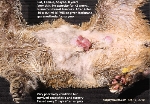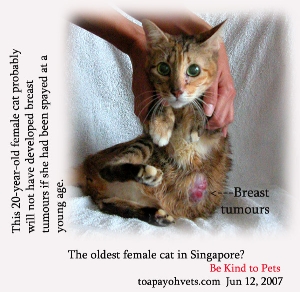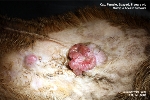The following experience is
shared. This was a high anaesthetic risk cat. The owner had
been told of the low chances of survival as the cat was very
thin and was not eating much. No blood tests were done
for economic reasons.
CONSULTATION. To
enhance her survival chances, I injected baytril, anti-fever
and anti-spasm drug in 10-ml dextrose saline SC. I
operated 2 hours later. Her rectal
temperature was normal. IV glucose was given first and
continued during surgery.
PRE-ANAESTHETIC SEDATION Zoletil 50 @ 0.1 ml IV. The
cat shot out a paw wanting to scratch my assistant Mr Saw when
he put the Zoletil bottle noisily on the table. Today, Mr Saw
seemed to be noisy. The cat had hissed at him before that.
This was surprisingly as she did not behave similarly towards
me and my second veterinary assistant Mr Goose.
"Maybe you are too noisy," I said. Mr Goose said as he grasped
the scruff of the cat's neck and held the hind leg for IV
injection of Zoletil. "Cats and rabbits at the preparation
room for surgery get nervous when the place is noisy."
Mr Goose pressed the medial side of the thigh to bring out a
dark blue vein. Zoletil 0.1 ml IV was safe for this 2-kg
8-year-old cat.
She was sedated. She had an IV glucose drip in her forearm
prior to this sedation.
Gas mask isoflurane anaesthesia after this gave her freedom
from pain during surgery. 3 minutes before the end of surgery,
the isoflurane gas was cut off. The cat was given oxygen to
breathe.
 SURGERY SURGERY
Two things to note:
1. The wound was very large as the mammary tumours were scattered.
Ensure sufficient skin to stitch up.
2. Bleeding from the superficial epigastric arteries (cranial
around MG1 and MG2 and caudal around MG4 and MG5). Clamp the
bleeding points and ligate.
3. Subcutaneous fat stitched to provide less tension for the
skin.
4. Skin stitched.
5. Body wrapped. E-collar.
POST-OP CARE
The cat was very weak and slept. I checked her tongue at the
end of surgery. It was bright pink as she had been given
glucose IV. Glucose by IV drip is necessary for such cases to
have a chance of survival under general anaesthetic. Continue
IV drip of dextrose saline and Hartmann's solution over the
next 24 hours. In this case, the cat passed away two days
after the surgery. This is the type of high-risk surgery that
I prefer not to do as the clinical outcome is not happy for me
or the owner. Death of a pet is highly emotional to me and the
owner in such instances.
TIPS FOR OLD
OWNERS
The
above is a case where a
 spayed cat still gets breast
tumours. Spaying reduces the incidence and most spayed
cats and dogs don't get breast tumours. spayed cat still gets breast
tumours. Spaying reduces the incidence and most spayed
cats and dogs don't get breast tumours.
It
is a matter of probability rather than a guarantee that
spaying will prevent mammary tumours in old age.
It is best to get breast tumours in cats and dogs removed by
your vet when they are much smaller. It will be less costly.
Big tumours of the mammary glands get ulcerated and
infected. The cat may then stop eating and die a painful
death. The picture (left) shows a very old cat with breast
tumours in Singapore. No surgery was done for her as she
was too old to take the stress of anaesthesia and surgery.
It is best for your
older cat if you get small breast tumours removed by your vet
early. Spayed cats and dogs usually don't get breast tumours.
However, spaying does not guarantee that there will be no
breast tumours. The chances of getting breast tumours are
less likely. I have seen cases of spayed dogs developing
breast tumours after 8 years of age but they are very rare.
Similarly with spayed cats.
 The above case study referred to a spayed cat with numerous
large breast tumours spread throughout her body. The cat was
very thin and the chances of survival on the operating table
were below 50%. The cat survived the anaesthesia and surgery
but passed away two days later. Therefore, it is best that you
get your vet to remove tumours when they are much small.
Veterinary costs will be much cheaper and most important of all, your cat
has higher chances of survival. The above case study referred to a spayed cat with numerous
large breast tumours spread throughout her body. The cat was
very thin and the chances of survival on the operating table
were below 50%. The cat survived the anaesthesia and surgery
but passed away two days later. Therefore, it is best that you
get your vet to remove tumours when they are much small.
Veterinary costs will be much cheaper and most important of all, your cat
has higher chances of survival.
|
 TOA
PAYOH VETS
TOA
PAYOH VETS TOA
PAYOH VETS
TOA
PAYOH VETS